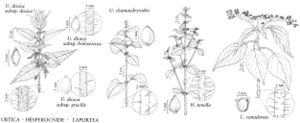Difference between revisions of "Laportea canadensis"
Ann. Sci. Nat., Bot., sér. 4, 1: 181. 1854.
FNA>Volume Importer |
imported>Volume Importer |
||
| (7 intermediate revisions by 2 users not shown) | |||
| Line 10: | Line 10: | ||
|special_status={{Treatment/ID/Special_status | |special_status={{Treatment/ID/Special_status | ||
|code=F | |code=F | ||
| − | |label= | + | |label=Illustrated |
}} | }} | ||
| − | |basionyms={{Treatment/ID/ | + | |basionyms={{Treatment/ID/Basionym |
|name=Urtica canadensis | |name=Urtica canadensis | ||
|authority=Linnaeus | |authority=Linnaeus | ||
| + | |rank=species | ||
| + | |publication_title=Sp. Pl. | ||
| + | |publication_place=2: 985. 1753 | ||
}} | }} | ||
|synonyms={{Treatment/ID/Synonym | |synonyms={{Treatment/ID/Synonym | ||
|name=Urticastrum divaricatum | |name=Urticastrum divaricatum | ||
|authority=(Linnaeus) Kuntze | |authority=(Linnaeus) Kuntze | ||
| + | |rank=species | ||
}} | }} | ||
|hierarchy=Urticaceae;Laportea;Laportea canadensis | |hierarchy=Urticaceae;Laportea;Laportea canadensis | ||
| Line 27: | Line 31: | ||
}}<!-- | }}<!-- | ||
| − | --><span class="statement" id="st- | + | --><span class="statement" id="st-undefined" data-properties=""><b>Herbs,</b> annual or perennial, rhizomatous, with tuberous roots, 3-15 dm, sparsely to densely covered with stinging hairs and nonglandular, nonstinging hairs, stipitate-glandular hairs absent. <b>Leaf</b> blades narrowly to broadly ovate, 6-30 × 3-18 cm, base rounded, truncate, or broadly cuneate, not auriculate, margins regularly serrate, apex acuminate. <b>Inflorescences</b> with staminate and pistillate flowers in separate panicles, proximal panicles staminate, distal panicles pistillate. <b>Staminate</b> flowers ca. 1-1.5 mm across; tepals5, equal in length; stamens5, opposite tepals; filaments slightly longer than tepals. <b>Pistillate</b> flowers ca. 0.5 mm; tepals 2-4, appressed, inner pair as long as ovary; ovary compressed, nearly orbicular to crescent-shaped; style persistent, feathery, 2-3 mm or more. <b>Achenes</b> strongly compressed, ± orbicular, ca. 2-3 mm. <b>2n</b>=26.</span><!-- |
-->{{Treatment/Body | -->{{Treatment/Body | ||
| Line 33: | Line 37: | ||
|habitat=Rich, moist, deciduous forests, often along seepages and streams | |habitat=Rich, moist, deciduous forests, often along seepages and streams | ||
|elevation=0-2000 m | |elevation=0-2000 m | ||
| − | |distribution=St. Pierre and Miquelon;Man.;N.B.;N.S.;Ont.;Que.;Sask.;Ala.;Ark.;Conn.;Del.;D.C.;Fla.;Ga.;Ill.;Ind.;Iowa;Kans.;Ky.;La.;Maine;Md.;Mass.;Mich.;Minn.;Miss.;Mo.;Nebr.;N.H.;N.J.;N.Y.;N.C.;N.Dak.;Ohio;Okla.;Pa.;R.I.;S.C.;S.Dak.;Tenn.;Vt.;Va.;W.Va.;Wis.;Mexico | + | |distribution=St. Pierre and Miquelon;Man.;N.B.;N.S.;Ont.;Que.;Sask.;Ala.;Ark.;Conn.;Del.;D.C.;Fla.;Ga.;Ill.;Ind.;Iowa;Kans.;Ky.;La.;Maine;Md.;Mass.;Mich.;Minn.;Miss.;Mo.;Nebr.;N.H.;N.J.;N.Y.;N.C.;N.Dak.;Ohio;Okla.;Pa.;R.I.;S.C.;S.Dak.;Tenn.;Vt.;Va.;W.Va.;Wis.;Mexico. |
| − | |discussion=<p>Native Americans used Laportea canadensis to treat incontinence and tuberculosis, to counteract poison, as a love medicine, and to facilitate childbirth (D.E. Moerman 1986).</p> | + | |discussion=<p>Native Americans used <i>Laportea canadensis</i> to treat incontinence and tuberculosis, to counteract poison, as a love medicine, and to facilitate childbirth (D.E. Moerman 1986).</p> |
|tables= | |tables= | ||
|references= | |references= | ||
| Line 43: | Line 47: | ||
-->{{#Taxon: | -->{{#Taxon: | ||
name=Laportea canadensis | name=Laportea canadensis | ||
| − | |||
|authority=(Linnaeus) Weddell | |authority=(Linnaeus) Weddell | ||
|rank=species | |rank=species | ||
| Line 53: | Line 56: | ||
|habitat=Rich, moist, deciduous forests, often along seepages and streams | |habitat=Rich, moist, deciduous forests, often along seepages and streams | ||
|elevation=0-2000 m | |elevation=0-2000 m | ||
| − | |distribution=St. Pierre and Miquelon;Man.;N.B.;N.S.;Ont.;Que.;Sask.;Ala.;Ark.;Conn.;Del.;D.C.;Fla.;Ga.;Ill.;Ind.;Iowa;Kans.;Ky.;La.;Maine;Md.;Mass.;Mich.;Minn.;Miss.;Mo.;Nebr.;N.H.;N.J.;N.Y.;N.C.;N.Dak.;Ohio;Okla.;Pa.;R.I.;S.C.;S.Dak.;Tenn.;Vt.;Va.;W.Va.;Wis.;Mexico | + | |distribution=St. Pierre and Miquelon;Man.;N.B.;N.S.;Ont.;Que.;Sask.;Ala.;Ark.;Conn.;Del.;D.C.;Fla.;Ga.;Ill.;Ind.;Iowa;Kans.;Ky.;La.;Maine;Md.;Mass.;Mich.;Minn.;Miss.;Mo.;Nebr.;N.H.;N.J.;N.Y.;N.C.;N.Dak.;Ohio;Okla.;Pa.;R.I.;S.C.;S.Dak.;Tenn.;Vt.;Va.;W.Va.;Wis.;Mexico. |
|reference=None | |reference=None | ||
|publication title=Ann. Sci. Nat., Bot., sér. | |publication title=Ann. Sci. Nat., Bot., sér. | ||
|publication year=1854 | |publication year=1854 | ||
| − | |special status= | + | |special status=Illustrated |
| − | |source xml=https:// | + | |source xml=https://bitbucket.org/aafc-mbb/fna-data-curation/src/2e0870ddd59836b60bcf96646a41e87ea5a5943a/coarse_grained_fna_xml/V3/V3_299.xml |
|genus=Laportea | |genus=Laportea | ||
|species=Laportea canadensis | |species=Laportea canadensis | ||
| − | |||
| − | |||
| − | |||
| − | |||
| − | |||
| − | |||
| − | |||
| − | |||
| − | |||
| − | |||
| − | |||
| − | |||
| − | |||
| − | |||
| − | |||
| − | |||
| − | |||
| − | |||
| − | |||
| − | |||
| − | |||
| − | |||
| − | |||
| − | |||
| − | |||
| − | |||
| − | |||
| − | |||
| − | |||
| − | |||
| − | |||
}}<!-- | }}<!-- | ||
-->[[Category:Treatment]][[Category:Laportea]] | -->[[Category:Treatment]][[Category:Laportea]] | ||
Latest revision as of 21:47, 5 November 2020
Herbs, annual or perennial, rhizomatous, with tuberous roots, 3-15 dm, sparsely to densely covered with stinging hairs and nonglandular, nonstinging hairs, stipitate-glandular hairs absent. Leaf blades narrowly to broadly ovate, 6-30 × 3-18 cm, base rounded, truncate, or broadly cuneate, not auriculate, margins regularly serrate, apex acuminate. Inflorescences with staminate and pistillate flowers in separate panicles, proximal panicles staminate, distal panicles pistillate. Staminate flowers ca. 1-1.5 mm across; tepals5, equal in length; stamens5, opposite tepals; filaments slightly longer than tepals. Pistillate flowers ca. 0.5 mm; tepals 2-4, appressed, inner pair as long as ovary; ovary compressed, nearly orbicular to crescent-shaped; style persistent, feathery, 2-3 mm or more. Achenes strongly compressed, ± orbicular, ca. 2-3 mm. 2n=26.
Phenology: Flowering spring–early fall.
Habitat: Rich, moist, deciduous forests, often along seepages and streams
Elevation: 0-2000 m
Distribution

St. Pierre and Miquelon, Man., N.B., N.S., Ont., Que., Sask., Ala., Ark., Conn., Del., D.C., Fla., Ga., Ill., Ind., Iowa, Kans., Ky., La., Maine, Md., Mass., Mich., Minn., Miss., Mo., Nebr., N.H., N.J., N.Y., N.C., N.Dak., Ohio, Okla., Pa., R.I., S.C., S.Dak., Tenn., Vt., Va., W.Va., Wis., Mexico.
Discussion
Native Americans used Laportea canadensis to treat incontinence and tuberculosis, to counteract poison, as a love medicine, and to facilitate childbirth (D.E. Moerman 1986).
Selected References
None.
